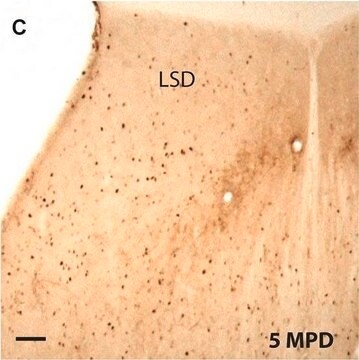AB1530
Anti-Peripherin Antibody
serum, Chemicon®
Synonim(y):
Anti-NEF4, Anti-PRPH1
About This Item
Polecane produkty
pochodzenie biologiczne
rabbit
Poziom jakości
forma przeciwciała
serum
rodzaj przeciwciała
primary antibodies
klon
polyclonal
reaktywność gatunkowa
rat, human, pig, bovine, mouse
producent / nazwa handlowa
Chemicon®
metody
immunohistochemistry (formalin-fixed, paraffin-embedded sections): suitable
western blot: suitable
numer dostępu NCBI
numer dostępu UniProt
Warunki transportu
dry ice
docelowa modyfikacja potranslacyjna
unmodified
informacje o genach
human ... PRPH2(5961)
Opis ogólny
Specyficzność
Immunogen
Zastosowanie
Immunohistochemistry:
A previous lot of this antibody was used at 1:100-1:200 dilution. It is suggested that the antibody be used on frozen sections fixed in acetone at -20°C. AB1530 will work on tissue fixed for one hour or less in fresh 4% paraformaldehyde. It has been reported that this antibody can be used on paraffin embedded tissue sections. See Cell & Tissue Research (1997) 288:11-23 & European J. Dermatology (1998) 8:339-342.
Electron Microscopy:
A previous lot of this antibody was used on Electron Microscopy.
Optimal working dilutions and protocols must be determined by end user.
Neuroscience
Sensory & PNS
Neuronal & Glial Markers
Jakość
Western Blot Analysis:
1:1000 dilution of this lot detected peripherin on 10 μg of PC12 lysates.
Opis wartości docelowych
Postać fizyczna
Przechowywanie i stabilność
Handling Recommendations: Upon first thaw, and prior to removing the cap, centrifuge the vial and gently mix the solution. Aliquot into microcentrifuge tubes and store at -20°C. Avoid repeated freeze/thaw cycles, which may damage IgG and affect product performance.
Komentarz do analizy
Rat sensory neurons, rat spinal cord homogenate and peripheral nerve homogenate.
Inne uwagi
Informacje prawne
Oświadczenie o zrzeczeniu się odpowiedzialności
Nie możesz znaleźć właściwego produktu?
Wypróbuj nasz Narzędzie selektora produktów.
polecane
Kod klasy składowania
12 - Non Combustible Liquids
Klasa zagrożenia wodnego (WGK)
WGK 1
Temperatura zapłonu (°F)
Not applicable
Temperatura zapłonu (°C)
Not applicable
Certyfikaty analizy (CoA)
Poszukaj Certyfikaty analizy (CoA), wpisując numer partii/serii produktów. Numery serii i partii można znaleźć na etykiecie produktu po słowach „seria” lub „partia”.
Masz już ten produkt?
Dokumenty związane z niedawno zakupionymi produktami zostały zamieszczone w Bibliotece dokumentów.
Nasz zespół naukowców ma doświadczenie we wszystkich obszarach badań, w tym w naukach przyrodniczych, materiałoznawstwie, syntezie chemicznej, chromatografii, analityce i wielu innych dziedzinach.
Skontaktuj się z zespołem ds. pomocy technicznej






